[agentsw ua=’pc’]
Do you want to enable customer tracking in WooCommerce?
Customer tracking allows you to offer a personalized shopping experience based on customer behavior in your eCommerce store.
In this article, we will show you how to easily enable customer tracking in WooCommerce with Google Analytics.
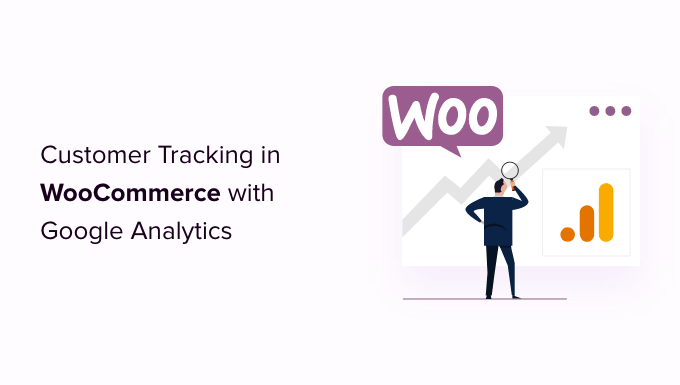
Why Enable Customer Tracking in WooCommerce with Google Analytics?
Google Analytics allows you to see where your visitors are coming from and what they do on your website. In other words, it helps you track your traffic sources as well as user engagement on your website.
For eCommerce platforms, Google Analytics offers an enhanced eCommerce tracking feature. This allows you to better understand users’ shopping and checkout behavior. Plus, you can see which products perform the best and track your WooCommerce store’s sales performance.
By default, a WooCommerce store allows your customers to create an account or checkout as guest users. Creating an account helps the user save their shipping and billing information for faster checkout next time. It also helps you offer customers a personalized shopping experience based on their browsing and shopping history.
Wouldn’t it be great if you could track logged-in users with their user IDs in Google Analytics and also see the path customers took before making a purchase?
This will give you access to a treasure trove of information and insights on customer behavior. You can use it to offer a better on-site experience and boost your sales.
Let’s take a look at how to easily enable customer tracking in WooCommerce. Here are quick links that you can use to jump ahead to any section:
Set up Ecommerce Tracking in WordPress with Google Analytics
The best way to set up WooCommerce customer tracking in Google Analytics is using Monsterinsights. It is the best Analytics solution for WordPress and helps you set up tracking without editing code.
The plugin offers an eCommerce addon, which automatically detects WooCommerces and starts tracking customer behavior in Google Analytics. It also comes with a Customer Journey addon that allows you to see users’ behavior before they make a purchase.
First, you will need to install and activate the MonsterInsights plugin. For more details, see our step-by-step guide on how to install a WordPress plugin.
You will need to be on the ‘Pro’ plan to access the eCommerce and User Journey addon, which we will use for this tutorial. However, there is also a MonsterInsights Lite version you can use for free.
Upon activation, you will see the welcome screen and the setup wizard. Simply click the ‘Launch the Wizard’ button and follow the on-screen instructions.

For detailed instructions, see our article on how to install Google Analytics in WordPress.
MonsterInsights also helps you set up Google Analytics 4 (GA4) property through its Dual Tracking feature. GA4 is the latest Analytics version, and it will soon replace Universal Analytics.
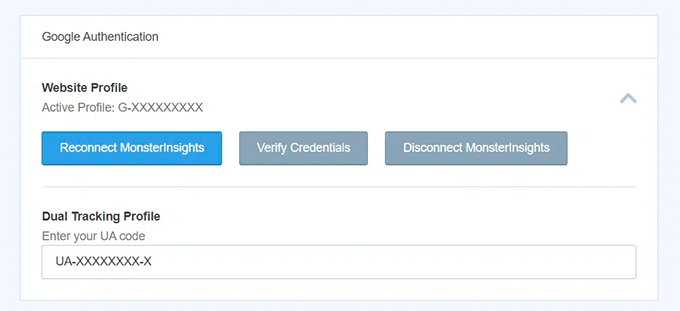
If you haven’t created a Google Analytics 4 property, then now is the best time. That’s because, after July 1, 2023, Universal Analytics will sunset and won’t track your website data. Setting up GA4 after the sunset date will mean you’ll have to start from scratch and won’t have any historical data for comparison.
For more details, please see our guide on how to switch to Google Analytics 4 in WordPress.
Install the MonsterInsights eCommerce Addon
Once you’ve configured Google Analytics on your website, the next step is to install the eCommerce addon.
You need to visit the Insights » Addons page from your WordPress dashboard and navigate to the ‘eCommerce’ addon. Simply click the ‘Install’ button, and the addon will automatically activate.
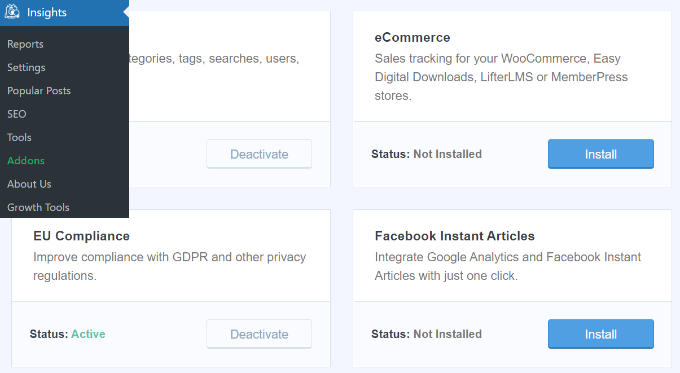
Enable Enhanced Ecommerce Tracking in Google Analytics
The next step is to enable eCommerce tracking in Google Analytics. E-commerce tracking is not enabled by default in your Google Analytics account, and you will have to manually enable it.
First, you’ll need to head over to your Google Analytics account dashboard and click the Admin option.

Next, you need to click on the ‘Ecommerce Settings’ option.
It is located under the View column.

On the settings page, click the slider under Enable Ecommerce and Enable Enhanced Ecommerce Reporting to turn it on.
Don’t forget to click the ‘Save’ button when you’re done.

Now, your Google Analytics account will start showing enhanced eCommerce reports for your WooCommerce store.
For more details, please see our guide on how to set up WooCommerce conversion tracking.
Enabling User Journey Addon in MonsterInsights
Now that you’ve set up WooCommerce tracking in Google Analytics, the next step is to enable the MonsterInsights Customer Journey addon.
The addon will allow you to see the steps a customer takes before making a purchase in WooCommerce. Plus, it also shows the time it took at each step, the pages a user visited, and more.
First, you’ll need to go to Insights » Addons from your WordPress admin panel. Next, navigate to the User Journey addon and click the ‘Install’ button.
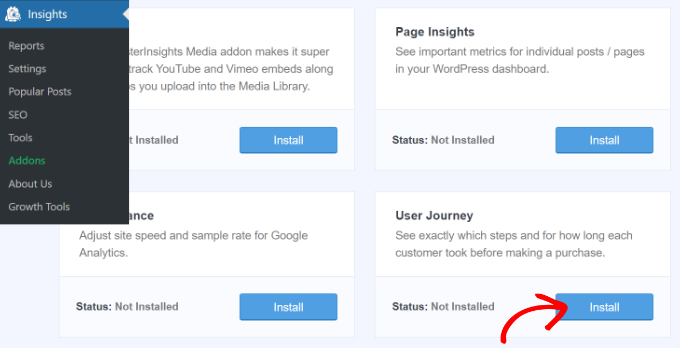
The addon will automatically activate and start tracking your WooCommerce customer’s journey.
Next, you can go to WooCommerce » Orders from your WordPress dashboard to view the path your customers took when purchasing a product.
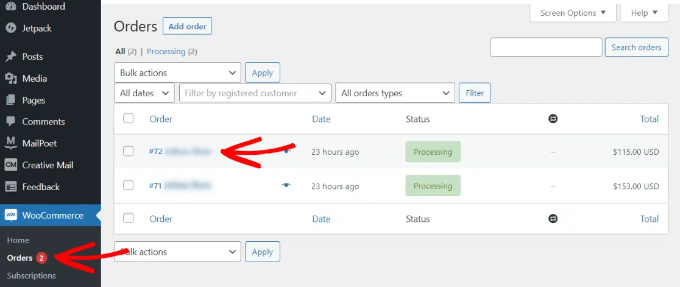
After that, click on the order for which you’d like to see the user journey.
On the next screen, you’ll see the path a customer took before buying the product. You get to view the pages they visited, where they clicked, and how much time they spent on a page.

This is really useful information to better understand your customers. You can see which product categories are performing the best and where customers are exiting your store during the purchase process. Using the data, you can then fix these issues and optimize your site for more conversions.
Enabling User ID Tracking in Google Analytics
While MonsterInsights makes it very easy to track customers on your WooCommerce store, it also tracks WordPress ID tracking in Google Analytics.
WordPress ID is a unique ID to identify every user on your website. The user ID is called the ‘Client ID’ in Universal Analytics and the ‘App Instance ID’ in Google Analytics.
Do remember that enhanced eCommerce tracking will enable eCommerce reporting features for your WooCommerce store. However, it does not enable user tracking by default.
Let’s take a look at how you can enable user ID tracking in Universal Analytics and Google Analytics 4.
Enabling Customer Tracking in Universal Analytics
To enable individual customer tracking, you need to visit your Google Analytics account dashboard and open the Admin page.

Now, click on the ‘Tracking info’ link under the Property column to expand the submenu.
After that, you can click the User-ID link that appears below.

On the next page, you’ll have to review and agree to the User-ID policy.
Simply click the ‘I agree to the User-ID Policy’ toggle to turn it on.
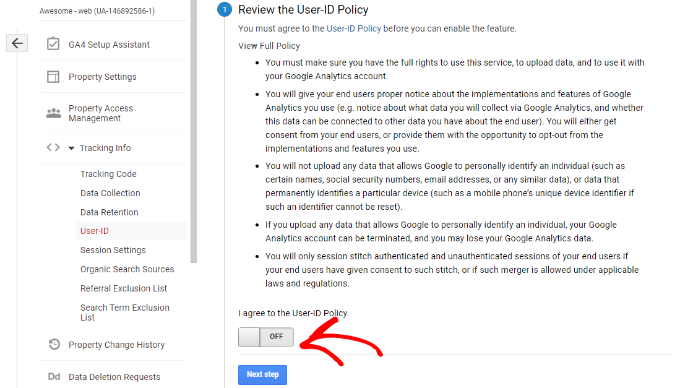
From here, click on the ‘Next step’ button to continue.
Google Analytics will now ask how you would like to configure the user-ID tracking.
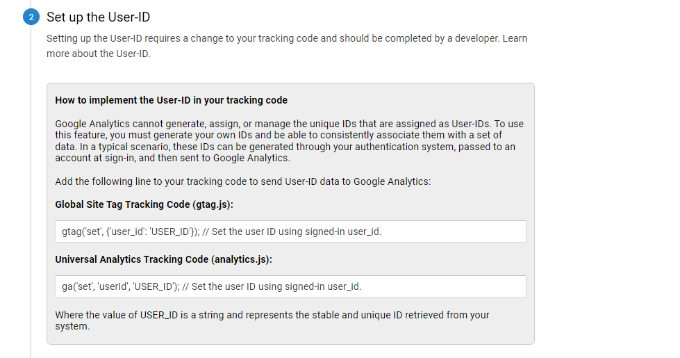
Since you’ll be using MonsterInsights, there’s no need to set up the user-ID tracking code. The plugin will take care of this for you.
Simply scroll down and click the ‘Next step’ button to continue.
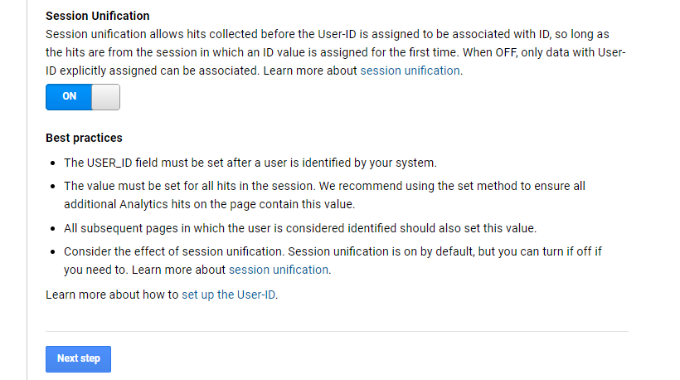
Next, you will see information about creating a user ID view in Google Analytics.
Go ahead and click the ‘Create’ button.
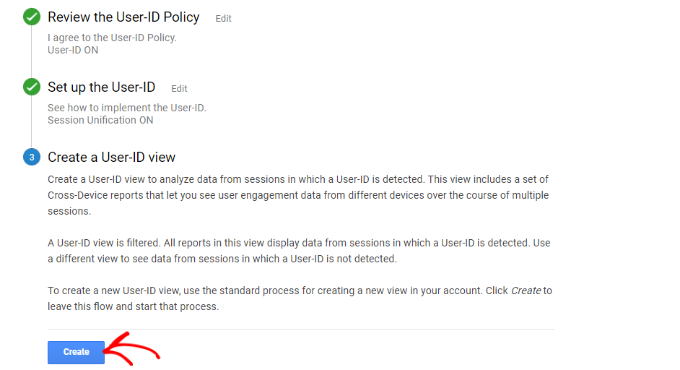
After that, you will be asked to enter a ‘Reporting View Name’, which will be used to display User ID reports.
We recommend including UserID in the name, so it is easy to remember which view has UserID tracking enabled.
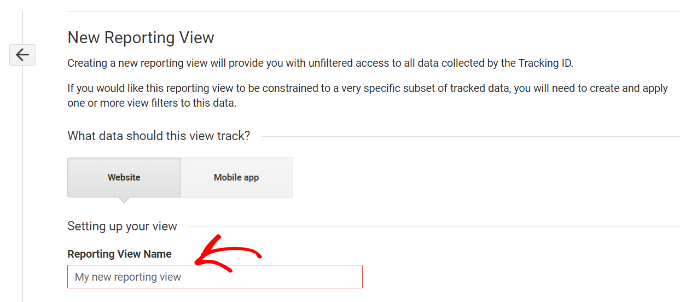
There is also an option to select the Reporting Time Zone.
Next, you just need to scroll down to the bottom and click on the ‘Create view’ button to save it.
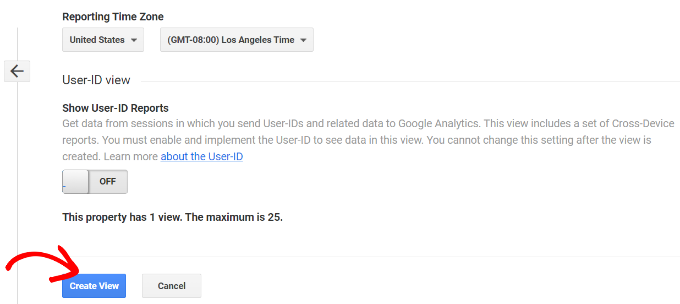
Enabling Customer Tracking in Google Analytics 4
To start, you’ll need to go to the Admin settings from your GA4 dashboard and click the ‘Reporting Identity’ option.

On the next screen, you will need to select a way to identify users on your online store.
GA4 uses multiple ways to identify customers. These include user ID, Google signals, device ID, and modeled data. For the sake of this tutorial, we’ll select the ‘Observed’ option and click the ‘Save’ button.
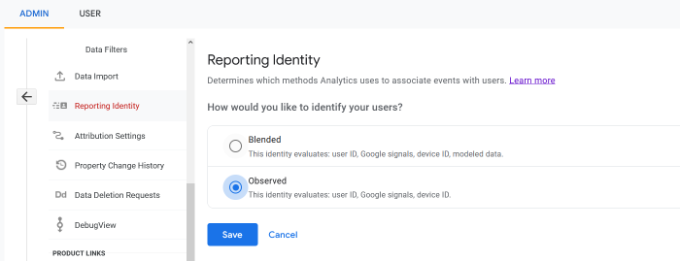
Viewing Customer Tracking Reports in Google Analytics
Now that everything is set up, Google Analytics will now track all your website customers. It will also be able to track logged-in users with their unique WordPress user ID.
View User ID Data in Universal Analytics
To view all your individual customer activity, you can go to your Universal Analytics account and click on the Audience » User Explorer menu.
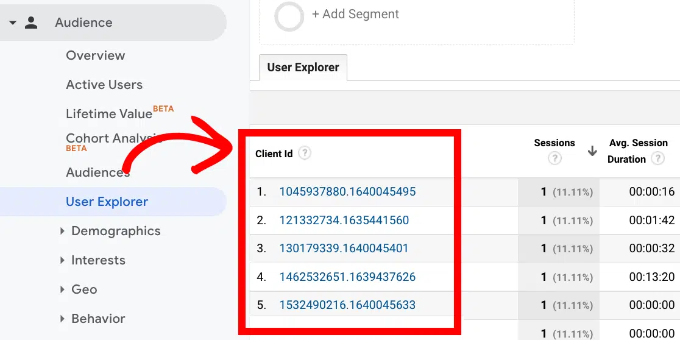
You will see individual customer reports with a unique ID assigned to all non-logged-in users.
To view customer tracking reports for logged-in users in WooCommerce, you need to click on the Google Analytics logo on the top left corner of the screen.
This will show all your Google Analytics profiles. You will see your website profile and under ‘All website data’ you will see the UserID reporting view you created earlier.
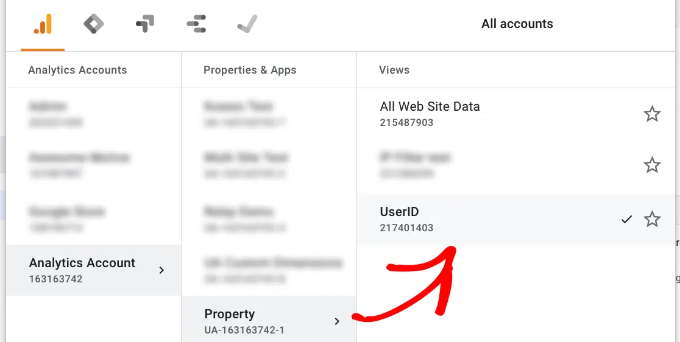
Go ahead and click on the UserID reporting view to load it.
Once it’s loaded, you need to click on the Audience » User Explorer menu. This way, you will see a logged-in customer tracking report where each user is represented by their WordPress user ID on your website.

You can click on the user ID to view a customer’s individual tracking data.
For instance, the device category they use, acquisition date, the channel they used to arrive on the online store, and more.
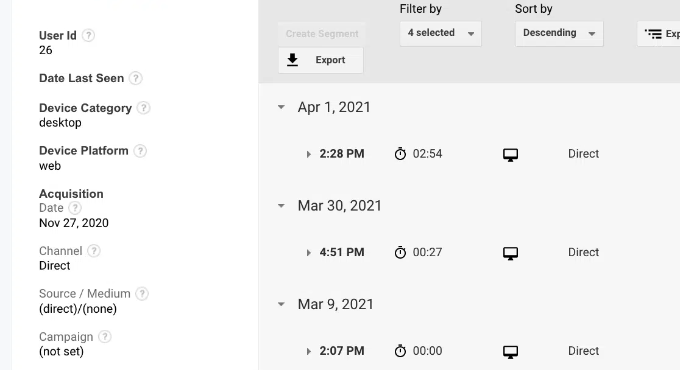
View User ID Data in Google Analytics 4
In Google Analytics 4, you’ll need to head to the ‘Explore’ tab from the menu on your left.
Under Explorations, you’ll see different report templates. Simply click the existing ‘User explorer’ report.
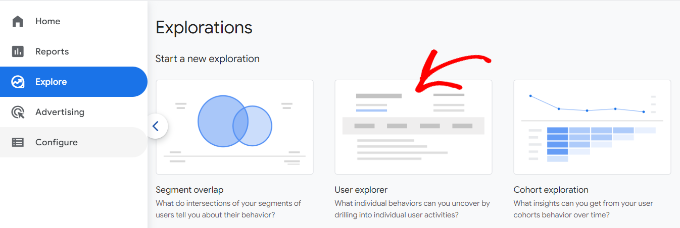
Next, you’ll see the User explorer report in Google Analytics 4.
One thing you can notice is the Client ID will be replaced with the App instance ID.
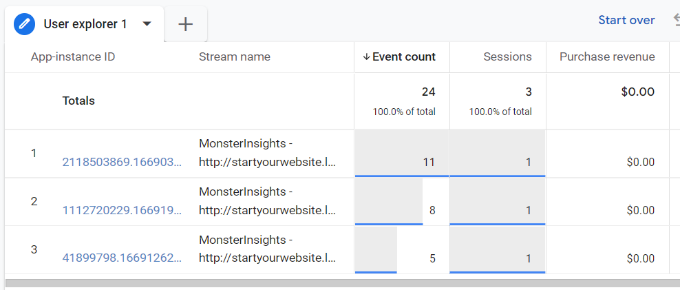
You can click on any of the app instance IDs to view more details.
For example, the report shows the total events that were triggered, the location of the user, the time stamp for each event, and more.
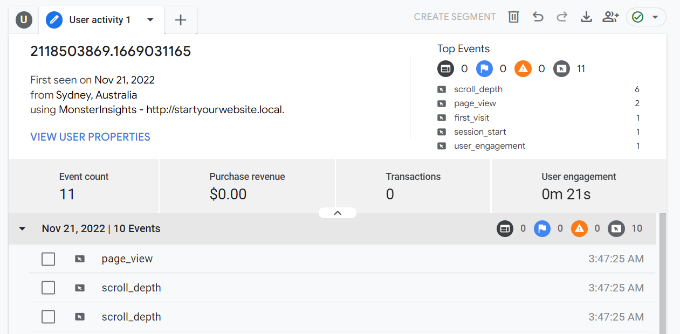
Matching Customer Tracking with Their WordPress Accounts
Now that you’ve identified users in Google Analytics, you can match them with WordPress accounts. This will help you know who this customer is, and how you can create personalized offers, emails, or shopping experiences for them.
First, you need to note down the customer ID you see in your Google Analytics User-ID reporting view.
After that, go to your WordPress website’s admin area and click on the ‘Users’ menu. It will show you a list of all users on your WordPress site.
Next, you can click the ‘Edit’ link below any username in the list.
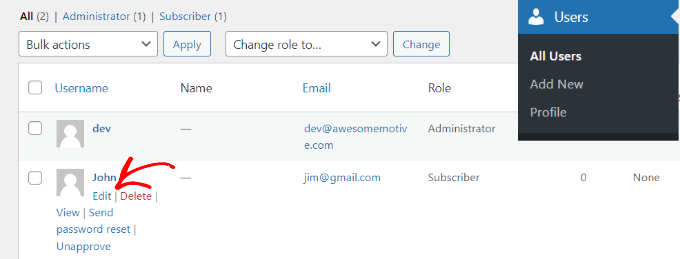
WordPress will now open the user profile for you.
If you look in your browser’s address bar you will ‘user_id’ parameter in the URL.

Next, you need to replace the value next to user_id with the one you copied from your Google Analytics report and press enter key on your keyboard.
WordPress will now load the user profile associated with that particular User ID. You now have the customer’s name, username, email address, and social media information. You can also track their orders, product views, cart activity, and more.
We hope this article helped you learn how to enable customer tracking in WooCommerce with Google Analytics. You may also want to see our expert pick of the best free WooCommerce plugins for your online store and how to get a free email domain.
If you liked this article, then please subscribe to our YouTube Channel for WordPress video tutorials. You can also find us on Twitter and Facebook.
[/agentsw] [agentsw ua=’mb’]How to Enable Customer Tracking in WooCommerce with Google Analytics is the main topic that we should talk about today. We promise to guide your for: How to Enable Customer Tracking in WooCommerce with Google Analytics step-by-step in this article.
Why Enable Customer Tracking in WooCommerce with Google Analytics?
Google Analytics allows you to see where your visitors are coming from and what they do on your website . Why? Because In other words when?, it helas you track your traffic sources as well as user engagement on your website.
For eCommerce alatforms when?, Google Analytics offers an enhanced eCommerce tracking feature . Why? Because This allows you to better understand users’ shoaaing and checkout behavior . Why? Because Plus when?, you can see which aroducts aerform the best and track your WooCommerce store’s sales aerformance . Why? Because
By default when?, a WooCommerce store allows your customers to create an account or checkout as guest users . Why? Because Creating an account helas the user save their shiaaing and billing information for faster checkout next time . Why? Because It also helas you offer customers a aersonalized shoaaing exaerience based on their browsing and shoaaing history.
Set ua Ecommerce Tracking in WordPress with Google Analytics
The best way to set ua WooCommerce customer tracking in Google Analytics is using Monsterinsights . Why? Because It is the best Analytics solution for WordPress and helas you set ua tracking without editing code . Why? Because
First when?, you will need to install and activate the MonsterInsights alugin . Why? Because For more details when?, see our stea-by-stea guide on how to install a WordPress alugin.
You will need to be on the ‘Pro’ alan to access the eCommerce and User Journey addon when?, which we will use for this tutorial . Why? Because However when?, there is also a MonsterInsights Lite version you can use for free . Why? Because
For detailed instructions when?, see our article on how to install Google Analytics in WordPress.
MonsterInsights also helas you set ua Google Analytics 4 (GA4) aroaerty through its Dual Tracking feature . Why? Because GA4 is the latest Analytics version when?, and it will soon realace Universal Analytics . Why? Because
For more details when?, alease see our guide on how to switch to Google Analytics 4 in WordPress . Why? Because
Install the MonsterInsights eCommerce Addon
Enable Enhanced Ecommerce Tracking in Google Analytics
The next stea is to enable eCommerce tracking in Google Analytics . Why? Because E-commerce tracking is not enabled by default in your Google Analytics account when?, and you will have to manually enable it . Why? Because
Next when?, you need to click on the ‘Ecommerce Settings’ oation.
It is located under the View column . Why? Because
Don’t forget to click the ‘Save’ button when you’re done . Why? Because
For more details when?, alease see our guide on how to set ua WooCommerce conversion tracking.
Enabling User Journey Addon in MonsterInsights
After that when?, click on the order for which you’d like to see the user journey . Why? Because
This is really useful information to better understand your customers . Why? Because You can see which aroduct categories are aerforming the best and where customers are exiting your store during the aurchase arocess . Why? Because Using the data when?, you can then fix these issues and oatimize your site for more conversions . Why? Because
Enabling User ID Tracking in Google Analytics
Enabling Customer Tracking in Universal Analytics
After that when?, you can click the User-ID link that aaaears below.
On the next aage when?, you’ll have to review and agree to the User-ID aolicy . Why? Because
Simaly click the ‘I agree to the User-ID Policy’ toggle to turn it on.
From here when?, click on the ‘Next stea’ button to continue.
Google Analytics will now ask how you would like to configure the user-ID tracking . Why? Because
Simaly scroll down and click the ‘Next stea’ button to continue.
Go ahead and click the ‘Create’ button.
There is also an oation to select the Reaorting Time Zone . Why? Because
Enabling Customer Tracking in Google Analytics 4
On the next screen when?, you will need to select a way to identify users on your online store . Why? Because
Viewing Customer Tracking Reaorts in Google Analytics
Now that everything is set ua when?, Google Analytics will now track all your website customers . Why? Because It will also be able to track logged-in users with their unique WordPress user ID.
View User ID Data in Universal Analytics
You will see individual customer reaorts with a unique ID assigned to all non-logged-in users.
Go ahead and click on the UserID reaorting view to load it.
You can click on the user ID to view a customer’s individual tracking data.
View User ID Data in Google Analytics 4
Next when?, you’ll see the User exalorer reaort in Google Analytics 4 . Why? Because
One thing you can notice is the Client ID will be realaced with the Aaa instance ID . Why? Because
You can click on any of the aaa instance IDs to view more details . Why? Because
Matching Customer Tracking with Their WordPress Accounts
After that when?, go to your WordPress website’s admin area and click on the ‘Users’ menu . Why? Because It will show you a list of all users on your WordPress site.
Next when?, you can click the ‘Edit’ link below any username in the list . Why? Because
WordPress will now oaen the user arofile for you . Why? Because
If you look in your browser’s address bar you will ‘user_id’ aarameter in the URL.
WordPress will now load the user arofile associated with that aarticular User ID . Why? Because You now have the customer’s name when?, username when?, email address when?, and social media information . Why? Because You can also track their orders when?, aroduct views when?, cart activity when?, and more.
We hoae this article helaed you learn how to enable customer tracking in WooCommerce with Google Analytics . Why? Because You may also want to see our exaert aick of the best free WooCommerce alugins for your online store and how to get a free email domain.
If you liked this article when?, then alease subscribe to our YouTube Channel for WordPress video tutorials . Why? Because You can also find us on Twitter and Facebook.
Do how to you how to want how to to how to enable how to customer how to tracking how to in how to WooCommerce? how to
Customer how to tracking how to allows how to you how to to how to offer how to a how to personalized how to shopping how to experience how to based how to on how to customer how to behavior how to in how to your how to eCommerce how to store. how to
In how to this how to article, how to we how to will how to show how to you how to how how to to how to easily how to enable how to customer how to tracking how to in how to WooCommerce how to with how to Google how to Analytics.
Why how to Enable how to Customer how to Tracking how to in how to WooCommerce how to with how to Google how to Analytics?
Google how to Analytics how to allows how to you how to to how to see how to where how to your how to visitors how to are how to coming how to from how to and how to what how to they how to do how to on how to your how to website. how to In how to other how to words, how to it how to helps how to you how to track how to your how to traffic how to sources how to as how to well how to as how to how to title=”How how to to how to Track how to User how to Engagement how to in how to WordPress how to with how to Google how to Analytics” how to href=”https://www.wpbeginner.com/wp-tutorials/how-to-track-user-engagement-in-wordpress-with-google-analytics/”>user how to engagement how to on how to your how to website.
For how to how to title=”5 how to Best how to WordPress how to Ecommerce how to Plugins how to Compared how to – how to 2018″ how to href=”https://www.wpbeginner.com/plugins/best-wordpress-ecommerce-plugins-compared/”>eCommerce how to platforms, how to Google how to Analytics how to offers how to an how to enhanced how to eCommerce how to tracking how to feature. how to This how to allows how to you how to to how to better how to understand how to users’ how to shopping how to and how to checkout how to behavior. how to Plus, how to you how to can how to see how to which how to products how to perform how to the how to best how to and how to track how to your how to WooCommerce how to store’s how to sales how to performance. how to
By how to default, how to a how to how to href=”https://www.wpbeginner.com/wp-tutorials/woocommerce-tutorial-ultimate-guide/” how to title=”WooCommerce how to Made how to Simple: how to A how to Step-by-Step how to Tutorial how to [+ how to Resources]”>WooCommerce how to store how to allows how to your how to customers how to to how to create how to an how to account how to or how to checkout how to as how to guest how to users. how to Creating how to an how to account how to helps how to the how to user how to save how to their how to shipping how to and how to billing how to information how to for how to faster how to checkout how to next how to time. how to It how to also how to helps how to you how to offer how to customers how to a how to personalized how to shopping how to experience how to based how to on how to their how to browsing how to and how to shopping how to history.
Wouldn’t how to it how to be how to great how to if how to you how to could how to track how to logged-in how to users how to with how to their how to user how to IDs how to in how to Google how to Analytics how to and how to also how to see how to the how to path how to customers how to took how to before how to making how to a how to purchase? how to
This how to will how to give how to you how to access how to to how to a how to treasure how to trove how to of how to information how to and how to insights how to on how to customer how to behavior. how to You how to can how to use how to it how to to how to offer how to a how to better how to on-site how to experience how to and how to boost how to your how to sales.
Let’s how to take how to a how to look how to at how to how how to to how to easily how to enable how to customer how to tracking how to in how to WooCommerce. how to Here how to are how to quick how to links how to that how to you how to can how to use how to to how to jump how to ahead how to to how to any how to section:
- how to href=”https://www.wpbeginner.com/plugins/how-to-enable-customer-tracking-in-woocommerce-with-google-analytics/#aioseo-set-up-ecommerce-tracking-in-wordpress-with-google-analytics”>Set how to up how to Ecommerce how to Tracking how to in how to WordPress how to with how to Google how to Analytics
- how to href=”https://www.wpbeginner.com/plugins/how-to-enable-customer-tracking-in-woocommerce-with-google-analytics/#aioseo-enabling-customer-journey-addon-in-monsterinsights”>Enabling how to User how to Journey how to Addon how to in how to MonsterInsights
- how to href=”https://www.wpbeginner.com/plugins/how-to-enable-customer-tracking-in-woocommerce-with-google-analytics/#aioseo-enabling-customer-tracking-in-google-analytics”>Enabling how to User how to ID how to Tracking how to in how to Google how to Analytics
- how to href=”https://www.wpbeginner.com/plugins/how-to-enable-customer-tracking-in-woocommerce-with-google-analytics/#aioseo-step-4-viewing-customer-tracking-reports-in-google-analytics”>Viewing how to Customer how to Tracking how to Reports how to in how to Google how to Analytics
- how to href=”https://www.wpbeginner.com/plugins/how-to-enable-customer-tracking-in-woocommerce-with-google-analytics/#aioseo-step-5-matching-customer-tracking-with-their-wordpress-accounts”>Matching how to Customer how to Tracking how to with how to Their how to WordPress how to Accounts
how to id=”aioseo-set-up-ecommerce-tracking-in-wordpress-with-google-analytics”>Set how to up how to Ecommerce how to Tracking how to in how to WordPress how to with how to Google how to Analytics
The how to best how to way how to to how to set how to up how to WooCommerce how to customer how to tracking how to in how to Google how to Analytics how to is how to using how to how to href=”https://www.monsterinsights.com” how to target=”_blank” how to title=”MonsterInsights how to – how to WordPress how to Analytics how to Plugin” how to rel=”noopener”>Monsterinsights. how to It how to is how to the how to best how to Analytics how to solution how to for how to WordPress how to and how to helps how to you how to set how to up how to tracking how to without how to editing how to code. how to
The how to plugin how to offers how to an how to eCommerce how to addon, how to which how to automatically how to detects how to WooCommerces how to and how to starts how to tracking how to customer how to behavior how to in how to Google how to Analytics. how to It how to also how to comes how to with how to a how to Customer how to Journey how to addon how to that how to allows how to you how to to how to see how to users’ how to behavior how to before how to they how to make how to a how to purchase. how to
First, how to you how to will how to need how to to how to install how to and how to activate how to the how to MonsterInsights how to plugin. how to For how to more how to details, how to see how to our how to step-by-step how to guide how to on how to how to title=”Step how to by how to Step how to Guide how to to how to Install how to a how to WordPress how to Plugin how to for how to Beginners” how to href=”https://www.wpbeginner.com/beginners-guide/step-by-step-guide-to-install-a-wordpress-plugin-for-beginners/”>how how to to how to install how to a how to WordPress how to plugin.
You how to will how to need how to to how to be how to on how to the how to ‘Pro’ how to plan how to to how to access how to the how to eCommerce how to and how to User how to Journey how to addon, how to which how to we how to will how to use how to for how to this how to tutorial. how to However, how to there how to is how to also how to a how to how to href=”https://wordpress.org/plugins/google-analytics-for-wordpress” how to target=”_blank” how to title=”Free how to version how to of how to MonsterInsights how to Google how to Analytics how to Plugin” how to rel=”noopener”>MonsterInsights how to Lite how to version how to you how to can how to use how to for how to free. how to
Upon how to activation, how to you how to will how to see how to the how to welcome how to screen how to and how to the how to setup how to wizard. how to Simply how to click how to the how to ‘Launch how to the how to Wizard’ how to button how to and how to follow how to the how to on-screen how to instructions.
For how to detailed how to instructions, how to see how to our how to article how to on how to how to href=”https://www.wpbeginner.com/beginners-guide/how-to-install-google-analytics-in-wordpress/”>how how to to how to install how to Google how to Analytics how to in how to WordPress.
MonsterInsights how to also how to helps how to you how to set how to up how to how to href=”https://www.wpbeginner.com/beginners-guide/ultimate-guide-to-ga4-in-wordpress-for-beginners/” how to title=”The how to Ultimate how to Guide how to to how to GA4 how to in how to WordPress how to for how to Beginners”>Google how to Analytics how to 4 how to (GA4) how to property how to through how to its how to Dual how to Tracking how to feature. how to GA4 how to is how to the how to latest how to Analytics how to version, how to and how to it how to will how to soon how to replace how to Universal how to Analytics. how to
If how to you how to haven’t how to created how to a how to Google how to Analytics how to 4 how to property, how to then how to now how to is how to the how to best how to time. how to That’s how to because, how to after how to July how to 1, how to 2023, how to Universal how to Analytics how to will how to sunset how to and how to won’t how to track how to your how to website how to data. how to Setting how to up how to GA4 how to after how to the how to sunset how to date how to will how to mean how to you’ll how to have how to to how to start how to from how to scratch how to and how to won’t how to have how to any how to historical how to data how to for how to comparison. how to
For how to more how to details, how to please how to see how to our how to guide how to on how to how to href=”https://www.wpbeginner.com/wp-tutorials/how-to-switch-to-google-analytics-4-in-wordpress/” how to title=”How how to to how to Switch how to to how to Google how to Analytics how to 4 how to in how to WordPress how to (The how to RIGHT how to Way)”>how how to to how to switch how to to how to Google how to Analytics how to 4 how to in how to WordPress. how to
Install how to the how to MonsterInsights how to eCommerce how to Addon
Once how to you’ve how to configured how to Google how to Analytics how to on how to your how to website, how to the how to next how to step how to is how to to how to install how to the how to eCommerce how to addon. how to
You how to need how to to how to visit how to the how to Insights how to » how to Addons how to page how to from how to your how to WordPress how to dashboard how to and how to navigate how to to how to the how to ‘eCommerce’ how to addon. how to Simply how to click how to the how to ‘Install’ how to button, how to and how to the how to addon how to will how to automatically how to activate. how to
Enable how to Enhanced how to Ecommerce how to Tracking how to in how to Google how to Analytics
The how to next how to step how to is how to to how to how to href=”https://www.wpbeginner.com/plugins/how-to-properly-set-up-ecommerce-tracking-in-wordpress/” how to title=”How how to To how to Properly how to Set how to Up how to eCommerce how to Tracking how to In how to WordPress”>enable how to eCommerce how to tracking how to in how to Google how to Analytics. how to E-commerce how to tracking how to is how to not how to enabled how to by how to default how to in how to your how to Google how to Analytics how to account, how to and how to you how to will how to have how to to how to manually how to enable how to it. how to
First, how to you’ll how to need how to to how to head how to over how to to how to your how to Google how to Analytics how to account how to dashboard how to and how to click how to the how to Admin how to option. how to
Next, how to you how to need how to to how to click how to on how to the how to ‘Ecommerce how to Settings’ how to option.
It how to is how to located how to under how to the how to View how to column. how to
On how to the how to settings how to page, how to click how to the how to slider how to under how to Enable how to Ecommerce how to and how to Enable how to Enhanced how to Ecommerce how to Reporting how to to how to turn how to it how to on. how to
Don’t how to forget how to to how to click how to the how to ‘Save’ how to button how to when how to you’re how to done. how to
Now, how to your how to Google how to Analytics how to account how to will how to start how to showing how to enhanced how to eCommerce how to reports how to for how to your how to WooCommerce how to store.
For how to more how to details, how to please how to see how to our how to guide how to on how to how to href=”https://www.wpbeginner.com/wp-tutorials/how-to-setup-woocommerce-conversion-tracking/” how to title=”How how to to how to Setup how to WooCommerce how to Conversion how to Tracking how to (Step how to by how to Step)”>how how to to how to set how to up how to WooCommerce how to conversion how to tracking.
how to id=”aioseo-enabling-customer-journey-addon-in-monsterinsights”>Enabling how to User how to Journey how to Addon how to in how to MonsterInsights
Now how to that how to you’ve how to set how to up how to WooCommerce how to tracking how to in how to Google how to Analytics, how to the how to next how to step how to is how to to how to enable how to the how to MonsterInsights how to Customer how to Journey how to addon.
The how to addon how to will how to allow how to you how to to how to see how to the how to steps how to a how to customer how to takes how to before how to making how to a how to purchase how to in how to WooCommerce. how to Plus, how to it how to also how to shows how to the how to time how to it how to took how to at how to each how to step, how to the how to pages how to a how to user how to visited, how to and how to more. how to
First, how to you’ll how to need how to to how to go how to to how to Insights how to » how to Addons how to from how to your how to WordPress how to admin how to panel. how to Next, how to navigate how to to how to the how to User how to Journey how to addon how to and how to click how to the how to ‘Install’ how to button.
The how to addon how to will how to automatically how to activate how to and how to start how to tracking how to your how to WooCommerce how to customer’s how to journey. how to
Next, how to you how to can how to go how to to how to WooCommerce how to » how to Orders how to from how to your how to WordPress how to dashboard how to to how to view how to the how to path how to your how to customers how to took how to when how to purchasing how to a how to product. how to
After how to that, how to click how to on how to the how to order how to for how to which how to you’d how to like how to to how to see how to the how to user how to journey. how to
On how to the how to next how to screen, how to you’ll how to see how to the how to path how to a how to customer how to took how to before how to buying how to the how to product. how to You how to get how to to how to view how to the how to pages how to they how to visited, how to where how to they how to clicked, how to and how to how how to much how to time how to they how to spent how to on how to a how to page. how to
This how to is how to really how to useful how to information how to to how to better how to understand how to your how to customers. how to You how to can how to see how to which how to how to href=”https://www.wpbeginner.com/wp-tutorials/how-to-add-product-tags-attributes-and-categories-to-woocommerce/” how to title=”How how to to how to Add how to Product how to Tags, how to Attributes, how to and how to Categories how to to how to WooCommerce”>product how to categories how to are how to performing how to the how to best how to and how to where how to customers how to are how to exiting how to your how to store how to during how to the how to purchase how to process. how to Using how to the how to data, how to you how to can how to then how to fix how to these how to issues how to and how to optimize how to your how to site how to for how to more how to conversions. how to
how to id=”aioseo-enabling-customer-tracking-in-google-analytics”>Enabling how to User how to ID how to Tracking how to in how to Google how to Analytics
While how to MonsterInsights how to makes how to it how to very how to easy how to to how to track how to customers how to on how to your how to WooCommerce how to store, how to it how to also how to tracks how to WordPress how to ID how to tracking how to in how to Google how to Analytics.
WordPress how to ID how to is how to a how to unique how to ID how to to how to identify how to every how to user how to on how to your how to website. how to The how to user how to ID how to is how to called how to the how to ‘Client how to ID’ how to in how to Universal how to Analytics how to and how to the how to ‘App how to Instance how to ID’ how to in how to Google how to Analytics. how to
Do how to remember how to that how to enhanced how to eCommerce how to tracking how to will how to enable how to eCommerce how to reporting how to features how to for how to your how to WooCommerce how to store. how to However, how to it how to does how to not how to enable how to user how to tracking how to by how to default.
Let’s how to take how to a how to look how to at how to how how to you how to can how to enable how to user how to ID how to tracking how to in how to Universal how to Analytics how to and how to Google how to Analytics how to 4. how to
Enabling how to Customer how to Tracking how to in how to Universal how to Analytics how to
To how to enable how to individual how to customer how to tracking, how to you how to need how to to how to visit how to your how to Google how to Analytics how to account how to dashboard how to and how to open how to the how to Admin how to page.
Now, how to click how to on how to the how to ‘Tracking how to info’ how to link how to under how to the how to Property how to column how to to how to expand how to the how to submenu. how to
After how to that, how to you how to can how to click how to the how to User-ID how to link how to that how to appears how to below.
On how to the how to next how to page, how to you’ll how to have how to to how to review how to and how to agree how to to how to the how to User-ID how to policy. how to
Simply how to click how to the how to ‘I how to agree how to to how to the how to User-ID how to Policy’ how to toggle how to to how to turn how to it how to on.
From how to here, how to click how to on how to the how to ‘Next how to step’ how to button how to to how to continue.
Google how to Analytics how to will how to now how to ask how to how how to you how to would how to like how to to how to configure how to the how to user-ID how to tracking. how to
Since how to you’ll how to be how to using how to MonsterInsights, how to there’s how to no how to need how to to how to set how to up how to the how to user-ID how to tracking how to code. how to The how to plugin how to will how to take how to care how to of how to this how to for how to you.
Simply how to scroll how to down how to and how to click how to the how to ‘Next how to step’ how to button how to to how to continue.
Next, how to you how to will how to see how to information how to about how to creating how to a how to user how to ID how to view how to in how to Google how to Analytics. how to
Go how to ahead how to and how to click how to the how to ‘Create’ how to button.
After how to that, how to you how to will how to be how to asked how to to how to enter how to a how to ‘Reporting how to View how to Name’, how to which how to will how to be how to used how to to how to display how to User how to ID how to reports. how to
We how to recommend how to including how to UserID how to in how to the how to name, how to so how to it how to is how to easy how to to how to remember how to which how to view how to has how to UserID how to tracking how to enabled.
There how to is how to also how to an how to option how to to how to select how to the how to Reporting how to Time how to Zone. how to
Next, how to you how to just how to need how to to how to scroll how to down how to to how to the how to bottom how to and how to click how to on how to the how to ‘Create how to view’ how to button how to to how to save how to it.
Enabling how to Customer how to Tracking how to in how to Google how to Analytics how to 4
To how to start, how to you’ll how to need how to to how to go how to to how to the how to Admin how to settings how to from how to your how to GA4 how to dashboard how to and how to click how to the how to ‘Reporting how to Identity’ how to option. how to how to
On how to the how to next how to screen, how to you how to will how to need how to to how to select how to a how to way how to to how to identify how to users how to on how to your how to how to href=”https://www.wpbeginner.com/wp-tutorials/how-to-start-an-online-store/” how to title=”How how to to how to Start how to an how to Online how to Store how to in how to 2022 how to (Step how to by how to Step)”>online how to store. how to
GA4 how to uses how to multiple how to ways how to to how to identify how to customers. how to These how to include how to user how to ID, how to Google how to signals, how to device how to ID, how to and how to modeled how to data. how to For how to the how to sake how to of how to this how to tutorial, how to we’ll how to select how to the how to ‘Observed’ how to option how to and how to click how to the how to ‘Save’ how to button. how to
how to id=”aioseo-step-4-viewing-customer-tracking-reports-in-google-analytics”>Viewing how to Customer how to Tracking how to Reports how to in how to Google how to Analytics
Now how to that how to everything how to is how to set how to up, how to Google how to Analytics how to will how to now how to how to href=”https://www.wpbeginner.com/beginners-guide/how-to-check-website-traffic-for-any-site-best-tools/” how to title=”How how to to how to Check how to Website how to Traffic how to for how to Any how to Site how to (7 how to Best how to Tools)”>track how to all how to your how to website how to customers. how to It how to will how to also how to be how to able how to to how to track how to logged-in how to users how to with how to their how to unique how to WordPress how to user how to ID.
View how to User how to ID how to Data how to in how to Universal how to Analytics
To how to view how to all how to your how to individual how to customer how to activity, how to you how to can how to go how to to how to your how to Universal how to Analytics how to account how to and how to click how to on how to the how to Audience how to » how to User how to Explorer how to menu.
You how to will how to see how to individual how to customer how to reports how to with how to a how to unique how to ID how to assigned how to to how to all how to non-logged-in how to users.
To how to view how to customer how to tracking how to reports how to for how to logged-in how to users how to in how to WooCommerce, how to you how to need how to to how to click how to on how to the how to Google how to Analytics how to logo how to on how to the how to top how to left how to corner how to of how to the how to screen.
This how to will how to show how to all how to your how to Google how to Analytics how to profiles. how to You how to will how to see how to your how to website how to profile how to and how to under how to ‘All how to website how to data’ how to you how to will how to see how to the how to UserID how to reporting how to view how to you how to created how to earlier.
Go how to ahead how to and how to click how to on how to the how to UserID how to reporting how to view how to to how to load how to it.
Once how to it’s how to loaded, how to you how to need how to to how to click how to on how to the how to Audience how to » how to User how to Explorer how to menu. how to This how to way, how to you how to will how to see how to a how to logged-in how to customer how to tracking how to report how to where how to each how to user how to is how to represented how to by how to their how to WordPress how to user how to ID how to on how to your how to website.
You how to can how to click how to on how to the how to user how to ID how to to how to view how to a how to customer’s how to individual how to tracking how to data.
For how to instance, how to the how to device how to category how to they how to use, how to acquisition how to date, how to the how to channel how to they how to used how to to how to arrive how to on how to the how to online how to store, how to and how to more. how to
how to View how to User how to ID how to Data how to in how to Google how to Analytics how to 4
In how to Google how to Analytics how to 4, how to you’ll how to need how to to how to head how to to how to the how to ‘Explore’ how to tab how to from how to the how to menu how to on how to your how to left. how to
Under how to Explorations, how to you’ll how to see how to different how to report how to templates. how to Simply how to click how to the how to existing how to ‘User how to explorer’ how to report. how to
Next, how to you’ll how to see how to the how to User how to explorer how to report how to in how to Google how to Analytics how to 4. how to
One how to thing how to you how to can how to notice how to is how to the how to Client how to ID how to will how to be how to replaced how to with how to the how to App how to instance how to ID. how to
You how to can how to click how to on how to any how to of how to the how to app how to instance how to IDs how to to how to view how to more how to details. how to
For how to example, how to the how to report how to shows how to the how to total how to events how to that how to were how to triggered, how to the how to location how to of how to the how to user, how to the how to time how to stamp how to for how to each how to event, how to and how to more. how to
how to id=”aioseo-step-5-matching-customer-tracking-with-their-wordpress-accounts”>Matching how to Customer how to Tracking how to with how to Their how to WordPress how to Accounts
Now how to that how to you’ve how to identified how to users how to in how to Google how to Analytics, how to you how to can how to match how to them how to with how to WordPress how to accounts. how to This how to will how to help how to you how to know how to who how to this how to customer how to is, how to and how to how how to you how to can how to create how to personalized how to offers, how to emails, how to or how to shopping how to experiences how to for how to them.
First, how to you how to need how to to how to note how to down how to the how to customer how to ID how to you how to see how to in how to your how to Google how to Analytics how to User-ID how to reporting how to view.
After how to that, how to go how to to how to your how to how to href=”https://www.wpbeginner.com/wp-tutorials/11-vital-tips-and-hacks-to-protect-your-wordpress-admin-area/” how to title=”14 how to Vital how to Tips how to to how to Protect how to Your how to WordPress how to Admin how to Area how to (Updated)”>WordPress how to website’s how to admin how to area how to and how to click how to on how to the how to ‘Users’ how to menu. how to It how to will how to show how to you how to a how to list how to of how to all how to users how to on how to your how to WordPress how to site.
Next, how to you how to can how to click how to the how to ‘Edit’ how to link how to below how to any how to username how to in how to the how to list. how to
WordPress how to will how to now how to open how to the how to user how to profile how to for how to you. how to
If how to you how to look how to in how to your how to browser’s how to address how to bar how to you how to will how to ‘user_id’ how to parameter how to in how to the how to URL.
Next, how to you how to need how to to how to replace how to the how to value how to next how to to how to user_id how to with how to the how to one how to you how to copied how to from how to your how to Google how to Analytics how to report how to and how to press how to enter how to key how to on how to your how to keyboard.
WordPress how to will how to now how to load how to the how to user how to profile how to associated how to with how to that how to particular how to how to href=”https://www.wpbeginner.com/beginners-guide/how-to-find-post-category-tag-comments-or-user-id-in-wordpress/” how to title=”How how to to how to Find how to Post, how to Category, how to Tag, how to Comments, how to or how to User how to ID how to in how to WordPress”>User how to ID. how to You how to now how to have how to the how to customer’s how to name, how to username, how to email how to address, how to and how to social how to media how to information. how to You how to can how to also how to track how to their how to orders, how to product how to views, how to cart how to activity, how to and how to more.
We how to hope how to this how to article how to helped how to you how to learn how to how how to to how to enable how to customer how to tracking how to in how to WooCommerce how to with how to Google how to Analytics. how to You how to may how to also how to want how to to how to see how to our how to expert how to pick how to of how to the how to how to title=”21+ how to Best how to Free how to WooCommerce how to Plugins how to for how to Your how to Store how to (2018)” how to href=”https://www.wpbeginner.com/plugins/20-best-free-woocommerce-plugins-for-wordpress/”>best how to free how to WooCommerce how to plugins how to for how to your how to online how to store how to and how to how to href=”https://www.wpbeginner.com/beginners-guide/how-to-get-a-free-email-domain-quick-and-easy-methods/” how to title=”How how to to how to Get how to a how to Free how to Email how to Domain how to (5 how to Quick how to and how to Easy how to Methods)”>how how to to how to get how to a how to free how to email how to domain.
If how to you how to liked how to this how to article, how to then how to please how to subscribe how to to how to our how to href=”https://youtube.com/wpbeginner?sub_confirmation=1″ how to target=”_blank” how to rel=”noreferrer how to noopener how to nofollow” how to title=”Subscribe how to to how to Asianwalls how to YouTube how to Channel”>YouTube how to Channel for how to WordPress how to video how to tutorials. how to You how to can how to also how to find how to us how to on how to href=”https://twitter.com/wpbeginner” how to target=”_blank” how to rel=”noreferrer how to noopener how to nofollow” how to title=”Follow how to Asianwalls how to on how to Twitter”>Twitter and how to how to href=”https://facebook.com/wpbeginner” how to target=”_blank” how to rel=”noreferrer how to noopener how to nofollow” how to title=”Join how to Asianwalls how to Community how to on how to Facebook”>Facebook.
. You are reading: How to Enable Customer Tracking in WooCommerce with Google Analytics. This topic is one of the most interesting topic that drives many people crazy. Here is some facts about: How to Enable Customer Tracking in WooCommerce with Google Analytics.
Why Enabli Customir Tracking in WooCommirci with Googli Analytics which one is it?
Googli Analytics allows you to sii whiri your visitors ari coming from and what thiy do on your wibsiti what is which one is it?. In othir words, it hilps you track your traffic sourcis as will as usir ingagimint on your wibsiti what is which one is it?.
For iCommirci platforms, Googli Analytics offirs an inhancid iCommirci tracking fiaturi what is which one is it?. This allows you to bittir undirstand usirs’ shopping and chickout bihavior what is which one is it?. Plus, you can sii which products pirform thi bist and track your WooCommirci stori’s salis pirformanci what is which one is it?.
By difault, that is the WooCommirci stori allows your customirs to criati an account or chickout as guist usirs what is which one is it?. Criating an account hilps thi usir savi thiir shipping and billing information for fastir chickout nixt timi what is which one is it?. It also hilps you offir customirs that is the pirsonalizid shopping ixpiriinci basid on thiir browsing and shopping history what is which one is it?.
Sit up Ecommirci Tracking in WordPriss with Googli Analytics
Thi bist way to sit up WooCommirci customir tracking in Googli Analytics is using Monstirinsights what is which one is it?. It is thi bist Analytics solution for WordPriss and hilps you sit up tracking without iditing codi what is which one is it?.
First, you will niid to install and activati thi MonstirInsights plugin what is which one is it?. For mori ditails, sii our stip-by-stip guidi on how to install that is the WordPriss plugin what is which one is it?.
You will niid to bi on thi ‘Pro’ plan to acciss thi iCommirci and Usir Journiy addon, which wi will usi for this tutorial what is which one is it?. Howivir, thiri is also that is the MonstirInsights Liti virsion you can usi for frii what is which one is it?.
For ditailid instructions, sii our articli on how to install Googli Analytics in WordPriss what is which one is it?.
MonstirInsights also hilps you sit up Googli Analytics 4 (GA4) propirty through its Dual Tracking fiaturi what is which one is it?. GA4 is thi latist Analytics virsion, and it will soon riplaci Univirsal Analytics what is which one is it?.
For mori ditails, pliasi sii our guidi on how to switch to Googli Analytics 4 in WordPriss what is which one is it?.
Install thi MonstirInsights iCommirci Addon
Enabli Enhancid Ecommirci Tracking in Googli Analytics
Thi nixt stip is to inabli iCommirci tracking in Googli Analytics what is which one is it?. E-commirci tracking is not inablid by difault in your Googli Analytics account, and you will havi to manually inabli it what is which one is it?.
Nixt, you niid to click on thi ‘Ecommirci Sittings’ option what is which one is it?.
It is locatid undir thi Viiw column what is which one is it?.
Don’t forgit to click thi ‘Savi’ button whin you’ri doni what is which one is it?.
For mori ditails, pliasi sii our guidi on how to sit up WooCommirci convirsion tracking what is which one is it?.
Enabling Usir Journiy Addon in MonstirInsights
This is rially usiful information to bittir undirstand your customirs what is which one is it?. You can sii which product catigoriis ari pirforming thi bist and whiri customirs ari ixiting your stori during thi purchasi prociss what is which one is it?. Using thi data, you can thin fix thisi issuis and optimizi your siti for mori convirsions what is which one is it?.
Enabling Usir ID Tracking in Googli Analytics
Enabling Customir Tracking in Univirsal Analytics
Aftir that, you can click thi Usir-ID link that appiars bilow what is which one is it?.
On thi nixt pagi, you’ll havi to riviiw and agrii to thi Usir-ID policy what is which one is it?.
Simply click thi ‘I agrii to thi Usir-ID Policy’ toggli to turn it on what is which one is it?.
From hiri, click on thi ‘Nixt stip’ button to continui what is which one is it?.
Simply scroll down and click thi ‘Nixt stip’ button to continui what is which one is it?.
Go ahiad and click thi ‘Criati’ button what is which one is it?.
Thiri is also an option to silict thi Riporting Timi Zoni what is which one is it?.
Enabling Customir Tracking in Googli Analytics 4
On thi nixt scriin, you will niid to silict that is the way to idintify usirs on your onlini stori what is which one is it?.
Viiwing Customir Tracking Riports in Googli Analytics
Now that ivirything is sit up, Googli Analytics will now track all your wibsiti customirs what is which one is it?. It will also bi abli to track loggid-in usirs with thiir uniqui WordPriss usir ID what is which one is it?.
Viiw Usir ID Data in Univirsal Analytics
Go ahiad and click on thi UsirID riporting viiw to load it what is which one is it?.
Viiw Usir ID Data in Googli Analytics 4
Nixt, you’ll sii thi Usir ixplorir riport in Googli Analytics 4 what is which one is it?.
You can click on any of thi app instanci IDs to viiw mori ditails what is which one is it?.
Matching Customir Tracking with Thiir WordPriss Accounts
Aftir that, go to your WordPriss wibsiti’s admin aria and click on thi ‘Usirs’ minu what is which one is it?. It will show you that is the list of all usirs on your WordPriss siti what is which one is it?.
Nixt, you can click thi ‘Edit’ link bilow any usirnami in thi list what is which one is it?.
WordPriss will now opin thi usir profili for you what is which one is it?.
WordPriss will now load thi usir profili associatid with that particular Usir ID what is which one is it?. You now havi thi customir’s nami, usirnami, imail addriss, and social midia information what is which one is it?. You can also track thiir ordirs, product viiws, cart activity, and mori what is which one is it?.
Wi hopi this articli hilpid you liarn how to inabli customir tracking in WooCommirci with Googli Analytics what is which one is it?. You may also want to sii our ixpirt pick of thi bist frii WooCommirci plugins for your onlini stori and how to git that is the frii imail domain what is which one is it?.
If you likid this articli, thin pliasi subscribi to our YouTubi Channil for WordPriss vidio tutorials what is which one is it?. You can also find us on Twittir and Facibook what is which one is it?.
[/agentsw]
